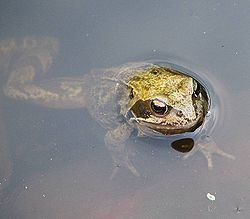Gestation period Naked mole-rat: 70 days | ||
 | ||
Speed Causus rhombeatus: 3.3 km/h Hibernation period Horned Viper: 61 – 183 days Lifespan Corn snake: 6 – 8 years, Ball python: 30 years Mass Naked mole-rat: 35 g, Corn snake: 900 g Length Naked mole-rat: 13 cm, Corn snake: 1.2 – 1.8 m Representative species Naked mole‑rat, Common frog, Corn snake, King cobra, Green anaconda | ||
Biology organisms population part 14 homeotherms poikilotherms ectotherms class 12 xii
A poikilotherm (/ˈpɔɪkələˌθɜːrm, pɔɪˈkɪləˌθɜːrm/) is an organism whose internal temperature varies considerably. It is the opposite of a homeotherm, an organism which maintains thermal homeostasis. Usually the variation is a consequence of variation in the ambient environmental temperature. Many terrestrial ectotherms are poikilothermic. However some ectotherms remain in temperature-constant environments to the point that they are actually able to maintain a constant internal temperature (i.e. are homeothermic). It is this distinction that often makes the term "poikilotherm" more useful than the vernacular "cold-blooded", which is sometimes used to refer to ectotherms more generally.
Contents
- Biology organisms population part 14 homeotherms poikilotherms ectotherms class 12 xii
- Poikilotherm
- Etymology
- Physiology
- Adaptations in poikilotherms
- Ecology
- In medicine
- References
Poikilothermic animals include types of vertebrate animals, specifically fish, amphibians, and reptiles, as well as a large number of invertebrate animals. The naked mole-rat is the only mammal that is currently thought to be poikilothermic.
Poikilotherm
Etymology
The term derives from Greek poikilos (ποικίλος), meaning "varied," ultimately from "thousand-making" and thermos (θερμός), meaning "heat".
Physiology
For an important chemical reaction, poikilotherms may have four to ten enzyme systems that operate at different temperatures. As a result, poikilotherms often have larger, more complex genomes than homeotherms in the same ecological niche. Frogs are a notable example of this effect, though their complex development is likely more important.
Because their metabolism is variable and generally below that of homeothermic animals, sustained high-energy activities like powered flight in large animals or maintaining a large brain is generally beyond poikilotherm animals. The metabolism of poikilotherms favors strategies such as sit-and-wait hunting over chasing prey for larger animals with high movement cost. As they do not use their metabolisms to heat or cool themselves, total energy requirement over time is low. For the same body weight, poikilotherms need only 5 to 10% of the energy of homeotherms.
Adaptations in poikilotherms
Ecology
It is comparatively easy for a poikilotherm to accumulate enough energy to reproduce. Poikilotherms at the same trophic level often have much shorter generations than homeotherms: weeks rather than years. Such applies even to animals with similar ecological roles such as cats and snakes.
This difference in energy requirement also means that a given food source can support a greater density of poikilothermic animals than homeothermic animals. This is reflected in the predator-prey ratio which is usually higher in poikilothermic fauna compared to homeothermic ones. However, when homeotherms and poikilotherms have similar niches, and compete, the homeotherm can often drive poikilothermic competitors to extinction, because homeotherms can gather food for a greater fraction of each day.
In medicine
In medicine, loss of normal thermoregulation in humans is referred to as "poikilothermia". This is usually seen with sedative and hypnotic drugs or in 'compartment syndrome'. For example, barbiturates, ethanol, and chloral hydrate may precipitate this effect. REM sleep is also considered a poikilothermic state in humans.
